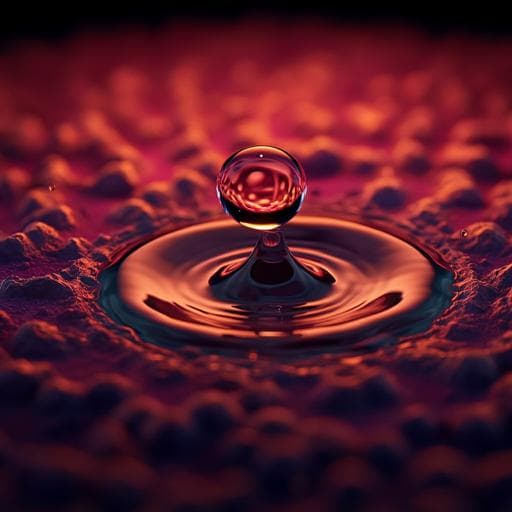
Environmental Studies and Forestry
Solar water purification with photocatalytic nanocomposite filter based on TiO2 nanowires and carbon nanotubes
E. Horváth, J. Gabathuler, et al.
Discover an innovative sunlight-powered photocatalytic water filter that effectively eliminates microbial pathogens while reducing harmful drug and pesticide traces. This groundbreaking research, conducted by E. Horváth, J. Gabathuler, G. Bourdiec, and their colleagues, leverages TiO2 nanowires and carbon nanotubes to enhance water purification through advanced photocatalytic processes.
~3 min • Beginner • English
Introduction
The paper addresses the global challenge of providing safe drinking water in regions lacking sanitary infrastructure and reliable electricity. Billions consume fecally contaminated water, and waterborne pathogens (e.g., E. coli, Salmonella, Cryptosporidium, Hepatitis A, Legionella) cause serious disease and death. Photocatalysis using sunlight and nanoscale TiO2 has been studied since 1985 for water disinfection due to ROS generation (OH, O2−, H2O2, singlet oxygen). However, practical sunlight-driven TiO2 devices are hindered by challenges in nanoparticle recovery in slurries and instability of immobilized TiO2 nanoparticle coatings. The study’s purpose is to design a durable, efficient photocatalytic filter based on TiO2 nanowires interwoven with CNTs that can trap and inactivate pathogens and degrade organic contaminants using only sunlight, adding a photothermal pasteurization channel from CNTs.
Literature Review
Prior work established TiO2 photocatalysis for detoxification and microbial disinfection, typically using nanoparticles or nanowires to maximize surface area for ROS generation under UV. Difficulties arise in slurry systems (recovery/reuse of 20–100 nm particles) and in immobilized films (mechanical instability and detachment). CNTs combined with semiconductors (TiO2, ZnO) can enhance photocatalysis by accepting electrons, improving charge separation, and increasing absorption/photothermal heating. Photocatalytic removal of dyes like methyl orange is a standard assay for ROS activity. The authors position their work to overcome immobilization and durability challenges by using fused TiO2 nanowire membranes reinforced with CNTs, and discuss potential plasmonic enhancement with Au nanoparticles and light-trapping surface structures, inspired by photovoltaic light management literature.
Methodology
- Materials synthesis:
- TiO2NWs: TiO2 nanopowder (20–50 nm) dissolved in NaOH, mixed at 70 °C for 1–24 h to form titanate (H2Ti3O7) nanowires; separated by centrifugation and converted to anatase TiO2NWs via heat treatment at 600 °C. Specific surface area ~150 m²/g. Production scale ~0.3–1.0 kg/day in lab.
- CNTs: Continuous CVD in an inclined rotary tube furnace (80 mm quartz tube). Catalyst: Fe2Ni on CaCO3 continuously fed; gases: C2H2 at 10 L/h and Ar at 80 L/h. Purification in 1.5 M HCl, filtering, water wash, drying at 120 °C overnight. Production ~1.2 kg/day. Specific surface area ~700 m²/g.
- Composite filter fabrication:
- TiO2NWs and CNTs mixed at various wt% (0–2% CNT) and doctor-bladed into films 2–300 µm thick on hydrophobic supports; air-dried at 120 °C and vacuum-calcined at 600 °C to fuse nanowires into robust membranes (phase transform to anatase). Freestanding discs (e.g., 50 µm thick, 20 mm diameter) and large sheets (~0.3 m²) prepared.
- SEM and TEM used to characterize morphology (individual nanowires and multiwalled CNTs, and membrane structure).
- Prototype device:
- A 30 µm-thick filter sheet (37.5 × 28.0 cm) clamped between two 1.5 mm borosilicate glass panes in an aluminum frame, with diagonally opposed inlet/outlet. Sun-facing area ~0.1 m² (adjustable angle θ). Internal volume 200 ± 50 mL. Flow driven by gravity; pressure head controlled by height difference h.
- Thermal characterization: Surface temperature under sunlight measured by thermocouple and FLIR infrared camera during ~60 min exposure; peak ~52–53 °C on a sunny June afternoon in Lausanne.
- Flow characterization: Volume-throughput vs time measured for h = 75, 120, 160 cm, compared to Darcy’s law; linear trends with slight nonlinearity at higher h implying small pressure losses. Daily production estimate ~2 L/day for the small-area setup.
- Photocatalytic ROS assays:
- ESR with TEMPOL spin probe (400 µM aqueous) under UV-A (367 nm, ~1–3 mW/cm²) and under sunlight. TEMPOL decay and TEMPONE growth monitored using X-band cw-ESR (Bruker EleXsys E500). Samples (~20 µL) collected at inlet and outlet over ~2.5 h; double integration used for quantification.
- Methyl orange (MO) photodegradation: MO 20 mg/L in water in Petri dishes over 50 mm discs; UV-A source LC-8 Lightingcure (365 nm, 16 mW/cm²); absorbance at 464 nm tracked every 10 min (Varian Cary 50). Compared TiO2NWs/CNTs vs Degussa P25 TiO2NPs on Al2O3 membrane and bare Al2O3 control.
- Micropollutant removal: 5 L cocktail of nine micropollutants (atrazine, carbamazepine, diclofenac, mecoprop, metolachlor, benzotriazole, iomeprol/lomeprol, gabapentin, metformin) at hundreds of ng/L. After each pass, HPLC separation and MS quantification; UVA illumination at 365 nm (1–3 mW/cm²) initiated after initial dark pass.
- Microbiological tests:
- Mechanical removal: River water (La Chamberonne) diluted 1:100; Colilert/Quanti-Tray incubation at 35 °C for 24 h (also Colilert-18 at 44.5±0.2 °C for 18 h per Methods). Yellow wells (ONPG) and UV fluorescence (MUG) indicate coliforms/E. coli; CFU/100 mL estimated via MPN tables.
- Photoinactivation: E. coli at 2×10^8 CFU/mL; 5 µL spots placed on TiO2NWs/CNTs filter or on Teflon (control). UV-A (365 nm, 16 mW/cm²) exposures for 20–180 s; visible/sunlight exposures up to 600 s. Post-exposure, filter pieces rinsed in physiological saline for 60 min, serially diluted, plated on agar, incubated 24 h at 37 °C; CFU counted to determine survival.
- Additional characterizations:
- Pore retention using polystyrene beads (1.97 µm, 870 nm, 530 nm, 110 nm) via absorbance spectra before/after filtration.
- Light intensity measured with ML9002A meter. Thermal imaging with FLIR ONE (7.5–14 µm, 160×120 px, resolution 0.1 °C).
- Improvement concepts: Incorporation of Au nanoparticles (plasmonic heating and photocatalysis) and surface texturing (gratings) to enhance light trapping; SEM/TEM images provided, with optical response differences between structured and flat surfaces.
Key Findings
- Robust composite filter fabrication: Fused TiO2 nanowire membranes interwoven with CNTs formed freestanding, flexible, large-area (up to ~0.3 m²) filters with pore cut-off <1 µm and minimal release of nanostructures under normal flow.
- Prototype performance:
- Photothermal heating: Under sunlight, device reached ~52.2–52.9 °C within ~60 min (thermocouple and IR camera), attributed to broadband absorption by CNTs.
- Throughput: Gravity-fed operation produced linear volume vs time curves; even the small-area prototype delivered ~2.0 L/day of decontaminated water. Flow scaled with hydrostatic head h (75–160 cm), consistent with Darcy’s law, with minor deviations at higher h.
- ROS generation (ESR): Under sunlight and UV-A (367 nm, ~1–3 mW/cm²), TEMPOL signal decayed strongly after passage through the filter, with concomitant rise of TEMPONE, confirming substantial ROS generation at the filter surface.
- MO photodegradation: The TiO2NWs/CNTs filter achieved about twice the degradation efficiency of Degussa P25 TiO2 nanoparticles (on Al2O3) under UV-A 365 nm at 16 mW/cm², while bare Al2O3 showed negligible effect.
- Micropollutants (HPLC-MS): For gabapentin and metformin at hundreds ng/L, a ~25% concentration decrease occurred after the first dark pass (adsorption). A slight increase upon initiating UV-A (thermal desorption) was followed by small decreases over subsequent passes attributed to ROS-mediated degradation; modest effects likely due to low UV power density and short residence time under flow.
- Microbial removal and inactivation:
- Mechanical filtration: River water with >200 CFU/100 mL coliforms (yellow, fluorescent Quanti-Tray) was reduced to below 1 CFU/100 mL after filtration (no color change), reflecting effective retention through submicron pores.
- Photocatalytic/photothermal inactivation: E. coli (2×10^8 CFU/mL) deposited on the TiO2NWs/CNTs filter fell below detection after 60 s UV-A exposure (365 nm, 16 mW/cm²). Visible/sunlight exposure reduced E. coli to below detection in >300 s. Control on wet Teflon showed much weaker reductions under similar illumination.
- Mechanistic insights: CNTs enhance photocatalysis via charge separation and provide photothermal heating for pasteurization; proximity of trapped microbes to ROS generation sites enables rapid inactivation compared to dissolved chemicals under flow.
Discussion
The study demonstrates that a sunlight-powered TiO2NWs/CNTs composite filter can both physically retain and chemically inactivate pathogens, addressing the challenge of safe drinking water without electrical infrastructure. The fused nanowire architecture overcomes typical immobilized TiO2 stability issues, while CNTs enhance charge separation and deliver photothermal heating, enabling disinfection even under natural sunlight. Quantitative results show rapid E. coli inactivation (≤60 s under UV-A; minutes under sunlight), strong ROS activity (TEMPOL ESR), and superior dye degradation compared to P25. Mechanical filtration effectively removes coliforms to below detection, confirming submicron retention. Micropollutant reductions were modest under low UV intensity and flow, highlighting the importance of residence time and irradiance for chemical degradation; nonetheless, adsorption plus ROS indicate potential for further optimization. Flow-rate scaling with hydrostatic head supports practical gravity-fed operation. Overall, the findings validate the concept of a durable, scalable, and low-cost solar-driven photocatalytic-thermal filter for decentralized water purification.
Conclusion
A simple, durable thermo-photocatalytic TiO2NWs/CNTs composite filter driven solely by sunlight effectively filters and disinfects water by combining mechanical retention, ROS-mediated oxidation, and photothermal pasteurization. The prototype produced about 2 L/day, heated to ~52–53 °C under sunlight, showed strong ROS generation, doubled dye degradation efficiency versus P25, reduced river water coliforms to <1 CFU/100 mL, and rapidly inactivated E. coli. The approach is cost-effective, thermally stable, chemically inert, and suitable for scaling by increasing filter area. Future improvements include incorporating plasmonic Au nanoparticles to enhance light absorption and local heating, and surface texturing (e.g., gratings) to trap light and increase the illuminated active volume, thereby boosting ROS generation and overall performance.
Limitations
- Chemical degradation under flow was modest for trace micropollutants, likely due to low UV-A power density (1–3 mW/cm²) and short residence time within the ROS-active zone; stronger illumination or longer contact times may be needed.
- The ROS effective range is confined near the filter surface, favoring inactivation of surface-trapped microbes over dissolved molecules under dynamic flow.
- Flow-rate vs head height showed slight nonlinearity at higher h, suggesting minor pressure losses in the device.
- Reported daily throughput (~2 L/day) pertains to a small prototype; scaling requires larger illuminated areas and optimization of hydraulics and light management.
- The study focused on selected microbes and chemicals; broader pathogen spectra and diverse water matrices were not exhaustively tested.
Related Publications
Explore these studies to deepen your understanding of the subject.







